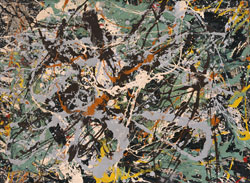…
Restoring a Jackson Pollock
By Gillian McMillan
Article originally appeared in Guggenheim Magazine, Fall 2005, pp. 20–21
Re-published with permission.

Jackson POLLOCK
American 1912–56
Untitled (Green Silver) c. 1949
enamel and aluminium paint on paper, mounted on canvas
57.8 x 78.1 cm
Solomon R. Guggenheim Museum, New York
Gift, Sylvia and Joseph Slifka
© Jackson Pollock/ARS, New York. Licensed by VISCOPY Australia
There is always considerable discussion before making a decision to clean a painting. A team of experts–conservators and curators, scholars from both inside and outside the Guggenheim–is brought together to debate the pros and cons of such a treatment, and various aspects of the painting and its history are considered. As cleaning is irreversible (unlike other treatments conservators undertake), a decision to do so is not made lightly. There is often value in the evidence of age and historic interest in the materials the work has been exposed to throughout its existence; this is especially true of historic or archaeological objects and sacred art. Generally though, the colors, composition, and illusion of space within a painting are so important to its perception and enjoyment that careful, safe cleaning is desirable. I am going to discuss briefly the cleaning/ restoration of Jackson Pollock’s Untitled (Green Silver) (ca. 1949), a recent gift to the Guggenheim. When it was acquired, the work was really in very good condition. Its surface, however, was covered in dirt, which was disfiguring and quite heavy in places, altering the image’s colors and tones and flattening its overall visual effect. All of the experts who saw this painting were in favor of cleaning it.
During my initial examination of this wonderful painting, what I found particularly interesting about its condition was the degree of difference between the accumulated dirt in certain areas versus in others. Normally dirt would be fairly evenly distributed across the surface. But with this painting, the various paints–some slick and shiny and others matte and porous–had attracted or absorbed the airborne dirt quite differently. In nearly 30 years of work as a conservator, I had never seen such disparate amounts of grime on the different colors that comprise a painting. As is well known, the artist turned to less traditional painting materials as he developed his famous dripping and pouring technique; he began to use paints in a liquid state, often household enamel paints of various types. Analysis of the paint samples revealed that Pollock had used both oil and alkyd paints to produce this work. In Untitled (Green Silver), the matte, porous paints had grasped more surface dirt over the years than the glossy, medium-rich paints. Thus it appears to have been the variety of paints Pollock used that caused the remarkably incoherent dirt layer across the painting’s surface. I found this to be such an interesting phenomenon that it warranted some investigation before beginning the cleaning process.
Surface dirt is very diverse and comes from all kinds of sources–tobacco smoke, dust from clothing and carpets, fly feces, food deposits, etc. As a result, some of the microscopic samples taken from the surface of the painting defied chemical analysis. However, analysis did reveal one especially interesting result: the most disfiguring grime of all, which was limited to the surface of one of the gray paints, was in fact a material that had exuded from the paint itself. A product of a chemical reaction between the pigment and the binding medium (a zinc oxide pigment and an oil medium, respectively), this material was no longer within the paint but had migrated to the paint’s surface, where its sticky texture was imbibing dirt. The greatest discoloring, therefore, was only partly caused by the accumulation of dirt; the majority of the discoloration in the most disfigured areas of the painting actually came from the paint itself. This exuded material was darkening and changing with time, its dark brown color obscuring the clear, gray paint beneath.
Removing the surface dirt and the slight amount of exuded material turned out to be a relatively simple matter. Minute cleaning tests were examined under the microscope to assess the removability of the surface grime, which, fortunately, was soluble in ordinary distilled water. Damp cotton swabs were applied gently to the painting’s surface, a square centimeter at a time, until all the dirt was removed from a particular area. After one area was dried, we moved on to the adjacent section, carefully keeping track of where we had cleaned. The process took several days to complete.
One of the great pleasures of being a conservator is that I have the privilege of seeing great works of art on intimate terms, both before and after their restoration. In Untitled (Green Silver), as much as the unusual accumulation of surface grime revealed something about Pollock’s technique, a sort of unintended diagram of the artist’s complex, multipaint choices, the dirt detracted too much from the vibrancy of the work and the decision to clean was rather obvious. The results of the cleaning are very rewarding. The painting’s mar-velous colors are revealed, allowing us to differentiate between the two types of silver paint Pollock used, or the two black paints (one very glossy, one very matte)–distinctions that were lost prior to the cleaning. Once again the silver paints sparkle and catch the light, all of the matte and gloss passages are visible, and the great depth of the composition is clear. No doubt, this is the vibrant painting that Pollock intended us to see.